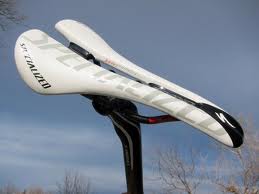Bicycling Neuropathy
Introduction
The paresthesia, numbness, or pain in the genital area associated with bicycling is often called “cyclist’s syndrome”. It may affect avid cyclists or amateurs. Scientific articles on the topic discuss both the hypoxia associated with compression of the blood vessels and compression of the pudendal nerve from pressure put on those areas by the bicycle saddle. There are many bicycle seats available that are designed to keep pressure off the sensitive nerves and blood vessels of the genital area.
Time Magazine article: Saddle Safety
Published Sunday, June 11th, 2006
written by Coeli Carr
Matthew Schmidt bought his first mountain bike 10 years ago, and from the onset his recreational rides in the idyllic Mount Tamalpais area of California’s Marin County left him numb in his personal undercarriage, where the crotch meets the bicycle saddle. Schmidt, 42, of San Rafael, Calif., dismissed the discomfort as the price to pay for vigorous riding on rough terrain. But by the end of 2002, the perineal pain and sexual problems he had experienced for years became intense. He stopped riding and, desperate for answers, saw several urologists before the last finally diagnosed pudendal-nerve damage, caused by his leaning into the protruding nose of his bicycle seat
Genitalia-friendly seats have been commercially available for years. Since 1983, Hobson Associates, based in the Los Angeles suburb of Reseda, has sold more than half a million of its noseless Easyseats, which feature a split seat that reduces pressure on the crotch and retail for about $30. The company has two new models set to debut this summer. Terry Precision Cycling in Macedon, N.Y., has more than a dozen styles for women and 10 for men, each with a traditional nose but a cutaway seat wider than most performance saddles. They range in price from $35 to $120 and are sold online and in bicycle shops in North America, Europe and Asia.
Matthew Schmidt says that had he–or his urologists–known about this type of seat early on, “it would have been a no-brainer. I’d have bought one immediately.” Now he advises friends to consider nontraditional seats. And, he says, because erectile dysfunction is becoming better recognized as a liability of bicycle riding, “the vast majority of men listen raptly to what I’m saying.”
Here is a link to this article in Time Magazine:
http://www.time.com/time/magazine/article/0,9171,1202941,00.html
Ideas for Bike Seats
Take a look at the new alternative seats made to help prevent neuropathic pain.
These seats were ergonomically made to help prevent neuropathic pain and are recommended for everyone, from children to adults. Some of these seats are recommended by PN specialists. If you already have neuropathic pain, it is recommended that you first speak with your doctor or PN specialist, to discuss any risk factors in furthering any damage to the nerve by using these seats. These seats are great and can help prevent neuropathy, but if you already have symptoms of neuropathic pain, it may continue to damage the nerve.
Click on the Images below to go directly to the website, for the particular bicycle seat you are interested in.
 This seat is called the Spongy Wonder Bicycle Seat. This seat is adjustable, so that you can move the seat inwards or outwards, to fit your size.
This seat is called the Spongy Wonder Bicycle Seat. This seat is adjustable, so that you can move the seat inwards or outwards, to fit your size.
 This seat is also adjustable. Whether you are large or small, you can adjust it so that it will fit your size.
This seat is also adjustable. Whether you are large or small, you can adjust it so that it will fit your size.
 If you are looking for a more “normal” looking seat, this one may be for you. It is called the Extra Deep Relief Zone Bicycle seat. This seat is not adjustable, so you will need to make sure you sit on it correctly at all times.
If you are looking for a more “normal” looking seat, this one may be for you. It is called the Extra Deep Relief Zone Bicycle seat. This seat is not adjustable, so you will need to make sure you sit on it correctly at all times.
Serious cyclists will want to consider custom fitted seats such as the Specialized “Body Geometry” saddle that can be measured to fit the cyclist. (No link available)

